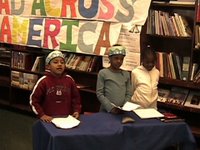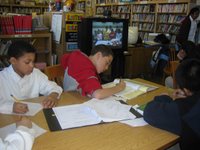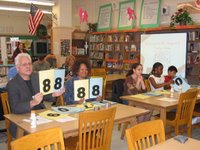
The videoconference started off with Rosemary Auld talking about the job of a meteorologist. She asked the students about their "Weather Cheetah" and what they were learning about weather. Then Jason Franklin got to tell the class about the job of an aviation meteorologist and how important their work is to keep planes flying safely. Then it was time for the students to ask questions. Another really nice touch here too. The students had e-mailed questions prior to the meteorologists. So, Marcie alternated between reading an e-mail question and having the student ask a live question. When she read an e-mail she asked the child who sent it to stand up. I know the students were very proud to have their questions read. One time she called out the name of about six students. She asked them to all stand up and hold hands. Then Marcie said their questions were all linked and that is why she wanted them to hold hands. They had all asked different questions about how weather moves.

The children also shared data they had been keeping everyday about temperatures. This is part of the globe project where the school has a weather station and they have instruments for recording weather information each day. This is really a 4th grade project but the 3rd graders are helping too. Rosemary Auld told them she would send them a box of materials so the could make their own weather instruments. Then they could compare how their school made instruments measured data compared to the special instruments they had in their school. The children were thrilled and very appreciative to be getting such an interesting package.

At the end the children were shown the National Oceanic & Atmospheric Administration (NOAA) website with a special site for children.
http://www.education.noaa.gov/students.html
I don't know what the weather will be tomorrow but today was sunny both inside and out.















